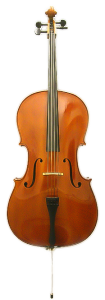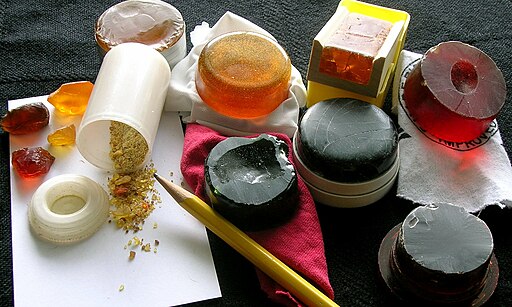Rent or Buy?

If you are uncertain about whether you want to play the cello for the long term, it may be best to start by renting. For younger children, there may be another reason to choose rental of an instrument: as the child grows, she will need to move up to a larger instrument. Most dealers have a program for trading up in rental instruments.
On the other hand, those rental fees do add up — if you rent for a year or longer, you may be well on your way to the price of your own instrument.
We encourage you to consult with your teacher before making the very important decision about rental or purchase of a cello. Deb will also be glad to assist you in selection of an instrument appropriate for your age and skill level.
Accessories
Having a cello is a start, but it’s not enough. There are a few accessories you will also need to have.
Your bow
The most essential accessory is your bow. Usually the bow doesn’t “come with” a cello, but is purchased separately. Traditionally, bows are made out of a tropical hardwood such as pernambuco, and can be surprisingly expensive. But for a beginner, the most “bang for the buck” is probably a carbon fiber bow. These are less subject to damage, and can give you higher quality for the same price. Whether you have a traditional wooden bow, or a new technology carbon fiber bow, your bow must have hair that is relatively fresh. The hair comes from the tails of horses that live in very cold climates, such as Alaska or Siberia. If you use your bow a lot (and we hope you do!), you’ll probably need new hair every 6-12 months. Deb can advise you about where to get your bow rehaired when the time comes.
Strings
From time to time you will need to replace the strings on your cello. They may break, they may become frayed, or they sometimes they just stop sounding as good as they could. You will need guidance about how to replace your strings for the first time, and Deb will be glad to help you with that. Strings can be ordered from online sellers, or purchased from music shops in Bend or Portland. There is a vast array of string types available, ranging from steel and titanium, through various synthetics and gut. You should ask Deb for advice about which is best for you and your cello.
Rosin
You’ll need a cake of rosin, which you’ll apply to the bow hair before each practice session. This is a relatively inexpensive accessory, but subject to messy breakage if you drop it. Deb will show you how to apply rosin to the bow. She can also advise you how to choose from among the many available types of rosin.
Cello case
Sometimes, but not always, your cello will come with a case. The least expensive case is a canvas bag, with a pocket for your bow, and perhaps another pocket for your sheet music. The canvas case protects against scratches, but doesn’t offer much protection against bumps or falls. The next step up is a padded case, which is more protective. But the best protection is offered by a hard case, made out of fiberglass, plywood or carbon fiber. If you are shipping your cello (or putting it in checked baggage on an airplane), there is yet another step up: a shipping case. Shipping cases are generally too heavy to be useful for everyday activities.
Music stand
For your practice sessions and some performances, you’ll need to have your own music stand. These come in several different shapes and sizes. The most affordable are collapsible stands which fold into a compact package. Other stands are not so compact, but may be more light weight or more durable over the long term.
Rockstop
Your parents, friends, teachers and performance halls will thank you if you don’t jam your cello endpin into their floors. Instead, use a rockstop – a small round sticky pad which stops your cello from slipping across the floor. They come in various shapes and materials, and with various names, but one of the most successful is marketed under the name “The Black Hole”. The cheaper versions lose their stickiness over time and no longer work as well. One alternative to the rockstop is a leather strap which is anchored at one end under a leg of your chair, and has a socket for your endpin at the other end.
Mute
Some composers like to change the sound of the cello by having you apply a mute. This is a small device that attaches to the bridge of the cello and stops some of the vibrations, changing the sound and making it quieter. Mutes come in many different forms. The bigger mutes (called “practice mutes”) are intended to quiet the cello very much, and are used by some musicians to practice late at night or in other situations where they don’t want to disturb their families or the neighbors in the next apartment. Generally, beginning students will not need to have a mute.
Metronome
A metronome is a device that makes a rhythmic clicking noise. This is helpful in many practice situations, to make sure that your rhythm is accurate. Older metronomes were spring driven, and you had to wind them like a clock. It was unfortunately very easy to damage these metronomes so that they no longer clicked accurately and evenly. More modern metronomes are electronic – more affordable, more precise and less likely to be damaged. Electronic metronomes also usually emit a tuning note (see next section). And the metronome function can sometimes be packaged together with a tuner. Metronomes are also available as an app (often free) for your iPhone, Android phone or computer. The quality of such apps can vary, and some apps have been known to slightly delay some beats! Be sure you check the accuracy of your app carefully before using it as a practice aid. One free metronome program for Windows which we know is accurate is Weird Metronome, created by Deb’s nephew, David Hernston.
Be sure you check the accuracy of your app carefully before using it as a practice aid. One free metronome program for Windows which we know is accurate is Weird Metronome, created by Deb’s nephew, David Hernston.
Tuning fork or tuner
Traditionally, every cellist needed to have a tuning fork. This device emitted a very accurate note (“A” or 440 vibrations per second) to which the cello’s top string is tuned. Today, most cellists have instead (or in addition) an electronic tuner. This may be as simple as a setting on your metronome that emits the A. But some devices have many more features. Some have an indicator needle – if you play a note into the tuner, the needle will tell you whether the note is sharp (high) or flat (low) or right on pitch. This device can be very helpful for every fingered note when you are working on playing in tune. Sometimes an electronic metronome and an electronic tuner can be packaged together as one device. (See photo). And like metronomes, tuners are available as apps for your iPhone, Android phone or computer.




